 By Scott Carlson,
By Scott Carlson,
For The Towson Flyer
Autumn is sauerkraut season. Cabbages — the main ingredient in kraut — ripen in the fall, sweetening with the cool weather. And that cool weather is perfect for the fermentation process, which thrives when temperatures are in the 60s and 70s.
Sauerkraut is an acquired taste. I find that most people who don’t like kraut had parents who made it through a cooked method, where the cabbage was heated on a stovetop. The krauts I make are all naturally fermented versions — always raw — with lots of spice. In the end, you have a colorful, sharply acidic vegetable garnish to add to pork sausages or sandwiches.
But what’s so great about sauerkraut that you’d go through the trouble to make it? These days, people are paying more attention to foods that have probiotic qualities, as some believe that these “living” foods inoculate your guts with helpful bacteria and yeast that fight off inflammation, cancer, digestive illnesses, and other ailments. Sandor Katz, a fermented-foods guru, is a big advocate for the health benefits of sauerkraut, describing it as the “gateway” to fermented foods because it is so easy to make. Whether sauerkraut really is a “superfood” is still a matter of scientific debate, but there are certainly lots of anecdotal examples of sauerkraut’s power. I know plenty of Germans, Bulgarians, and Czechs who love their kraut and are as strong as oxen. Something in the fermented garnish has to be working for them.
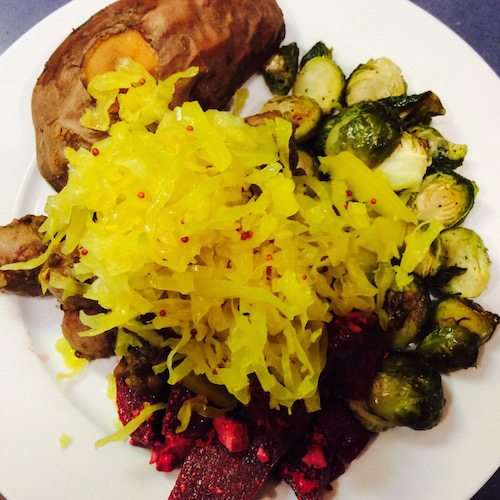
But I would say that you should eat kraut mainly because it tastes great, not simply because it’s some miracle food. And making it isn’t difficult: Just take cabbage, chop it into chunks, run it through the slicing blade on a food processor, and put it in a large bowl. Sprinkle spices and salt over it, then pack it into a vessel, like a jar or food-safe bucket. Cover it and wait several weeks. (More specific instructions are below.) During that time, lactic-acid bacteria will start to ferment the cabbage under the brine, softening the leaves, making more vitamins bioavailable, and souring the concoction. In the end, you’ll have kraut.
OK, it’s a little more complicated than that, but not much more. People who are making kraut for the first time generally wonder about which sauerkraut recipes to follow, what kind of vessels to use, how much salt to add, how long to ferment the kraut, and how to use the final product. Here are some answers:
Flavors: First, pick a sauerkraut recipe you like. Some common combinations are:
–Cabbage and caraway
–Cabbage, apple, and juniper berries
–Purple cabbage, garlic, and jalapeños
–Cabbage, fennel, and raisins
–Purple cabbage, carrots, and ginger
–Indian kraut, with carrots, onions, garlic and Indian spices
–Sea kraut, with cabbage, daikon radishes, and seaweed
And there are plenty more. Or you can just wing it, using whatever you have on hand and think might be good.
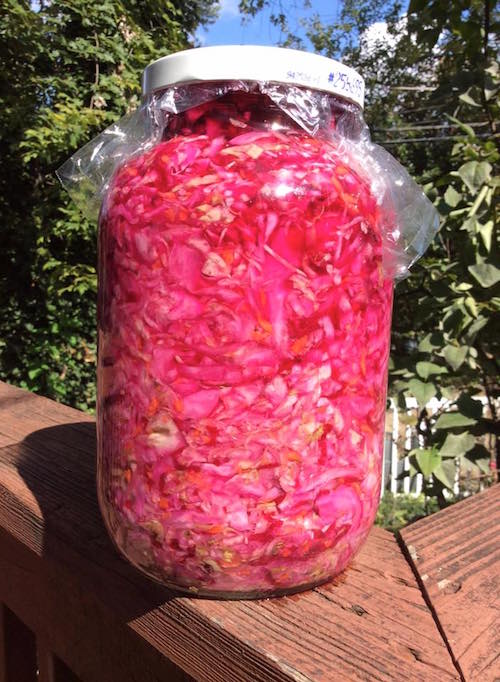
Vessels: Gather your ingredients with a large bowl and a vessel, two quarts or larger. (A quart jar isn’t big enough.) A ceramic crock is a traditional vessel. I usually use large jars that I find at Goodwill. It’s best if the jars have a glass or plastic top, not a metal lid, which will rust when exposed to the kraut brine. If you want to make a lot of kraut, you can also use a food-safe five-gallon bucket. Home-improvement stores sell versions with screw-off lids. Or you can also use the five-gallon buckets favored by beer homebrewers. (Those brewing buckets come with lids with a hole at the top where you can put an airlock. The airlock seals out oxygen, which helps the fermentation process — more on that in a bit.) The hardest part about picking a vessel is figuring out how much you can fit into it. I usually have a second vessel ready, in case I produced way more kraut than the first vessel will hold.
Slicing and Salting: Slice up the cabbage and vegetables and put them in the bowl, adding salt and spices with each layer and mixing as you go. (If you use buckets, you won’t need the large bowl. Just put the ingredients directly into the bucket.) The salt serves two purposes: It helps to extract water from the cabbage leaves (the kraut ferments in liquid) and it inhibits the growth of “bad” bacteria. Too much salt, however, will inhibit “good” bacteria and the fermentation process. Most recipes call for 2 to 3 percent salt. In practical terms, that translates to 1 tablespoon of salt per 1 3/4 pounds of vegetables, or 3 tablespoons per 5 pounds. I usually guesstimate, which has always worked for me.
Pack It Down, Keep It Submerged: Once you have sliced and salted the veggies, you’ll notice that they’ll start to release water. Using a tool like a rolling pin or a muddler — or your fist — pack the vegetable mixture into the vessel. There should be no air bubbles at the bottom, and the water should start to rise over the cabbage. When the vessel is almost full, add a little salt water to cover the cabbage. This is important: Sauerkraut is made through an anaerobic (or oxygen-free) fermentation process. The kraut — other than what’s on the surface — should not be exposed to air. The surface layer exposed to air will develop a white mold, but the kraut below is safe to eat. (This is the advantage of using a bucket with an airlock, which keeps most oxygen out.) To keep the kraut below the water’s surface, place a plate or some other food-safe heavy object to weigh down the cabbage. (The crocks sold at Hex Ferments in Belvedere Square come with ceramic weights.) With glass bottles in particular, do not tighten the lids. The vegetables will release gas as they ferment, and the accumulating pressure could crack the vessel.
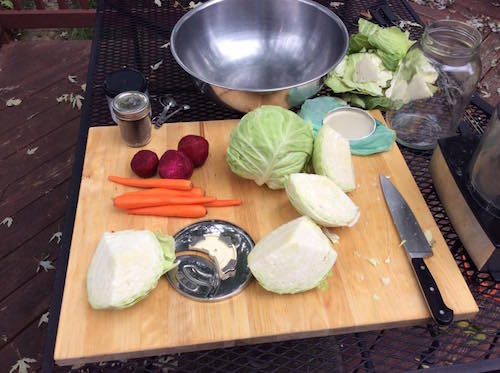
Check the Water Level: As the kraut ferments, it will expand, and the chopped vegetables might rise above the level of the water. Now and then, you may need to add salt water to the vessel to keep the cabbage submerged. The expanding cabbage might also push water out of the vessel, particularly if you’re using a glass jar. For that reason, you might need to put your vessel on a plate or glass baking dish to catch the overflow. And again, you might have to add salt water to top off the vessel and cover the cabbage with liquid. (Overflow is generally not a problem with buckets, which is another reason to use them.)
It’s Gonna Stink: Sliced cabbage doesn’t smell like roses anyway. Fermenting cabbage is downright pungent. [Editor’s note: This cannot be overstated.] My wife once teased me with an article describing how authorities in Sweden thought they had discovered toxic waste in barrels, only to have found sauerkraut. There are a few ways to deal with the smell: One way is to live with it. The stinky phase usually only lasts a couple of weeks. If you can’t tolerate the smell, you could try fermenting outside, which is particularly appropriate in the cooler autumn weather. If you have a garage, a shed, or another exterior shelter, put the vessels out there. To discourage insects or other vermin from digging around the vessels, fill the dish at the base with salt.
Let It Sit: Fermentation takes several weeks. Some people let their kraut sit for months. The kraut will get more tart the longer it sits. (Up to a point; fermentation will cease after a certain amount of time.) As long as the water levels are high, you needn’t worry about the kraut going bad. But trust your senses: If your kraut smells off, or if it develops an unappealingly rotten appearance, don’t eat it. Throw it out. However, generally you don’t need to worry about pathogens. As Sandor Katz has pointed out, fermented sauerkraut has myriad beneficial bacteria that outcompete the bad bacteria. However, again, the kraut at the top of the jar that has been exposed to air will develop a white mold. As you check your vessels, skim that off and don’t eat it. The kraut below is usually safe to eat, unless something has gone terribly wrong.
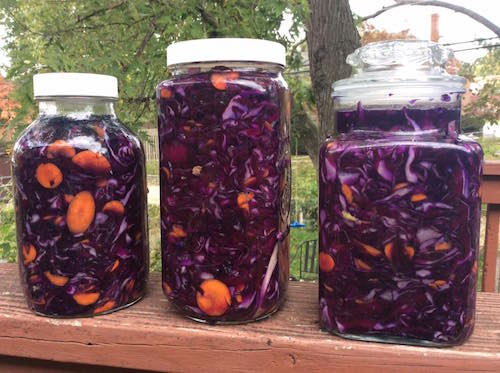
My Kraut Is Done. What Do I Do With It?: You have to store it. Just get some smaller containers that will fit in your fridge (if your vessel doesn’t already fit) and transfer the sauerkraut to those containers (taking care to first skim off the white mold at the top). Screw on the lid tightly, or your whole fridge will smell like kraut. The kraut should be stable in the fridge for a long time. I have had kraut hanging around for almost a year, and it’s still good. Some people store their kraut by canning it, putting it through a heat process. I think this defeats the purpose of making kraut, because the heat kills all the beneficial bacteria.
The Fun Part: The easiest and most enjoyable part of this whole exercise is eating it. Get some brats or sausages, grill them up, and cover them with kraut and mustard. Mmmmm. But there are other possibilities:
-Serve it with pork
-Use kraut in place of a pickle in a sandwich.
-Make a Reuben sandwich
-Put it in baked goods
-Put it in soup
-Make martinis from the sauerkraut juice
-Or just eat it raw, on its own.
Your adventures with kraut may inspire work with other fermented delights, like kefir or pickles. I may cover those foods in a post in the future. In the meantime, “Guten Appetit.”

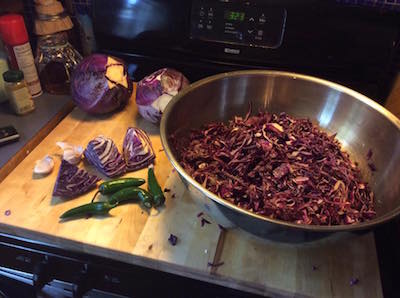
Simmer with lots of onions, tomato, a little brown sugar, and LOTS of caraway seeds. Great with the Thanksgiving turkey!
Yum.